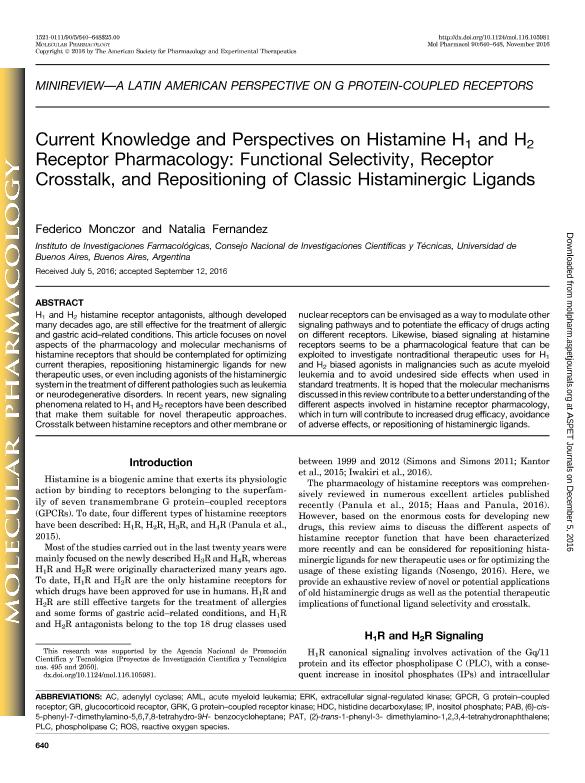Artículo
Current knowledge and perspectives on histamine H1 and H2 receptor pharmacology: Functional selectivity, receptor crosstalk, and repositioning of classic histaminergic ligands
Fecha de publicación:
11/2016
Editorial:
American Society for Pharmacology and Experimental Therapeutics
Revista:
Molecular Pharmacology
ISSN:
0026-895X
Idioma:
Inglés
Tipo de recurso:
Artículo publicado
Clasificación temática:
Resumen
H1 and H2 histamine receptor antagonists, although developed many decades ago, are still effective for the treatment of allergic and gastric acid-related conditions. This article focuses on novel aspects of the pharmacology and molecular mechanisms of histamine receptors that should be contemplated for optimizing current therapies, repositioning histaminergic ligands for new therapeutic uses, or even including agonists of the histaminergic system in the treatment of different pathologies such as leukemia or neurodegenerative disorders. In recent years, new signaling phenomena related to H1 and H2 receptors have been described that make them suitable for novel therapeutic approaches. Crosstalk between histamine receptors and other membrane or nuclear receptors can be envisaged as a way to modulate other signaling pathways and to potentiate the efficacy of drugs acting on different receptors. Likewise, biased signaling at histamine receptors seems to be a pharmacological feature that can be exploited to investigate nontraditional therapeutic uses for H1 and H2 biased agonists in malignancies such as acute myeloid leukemia and to avoid undesired side effects when used in standard treatments. It is hoped that the molecular mechanisms discussed in this reviewcontribute to a better understanding of the different aspects involved in histamine receptor pharmacology, which in turn will contribute to increased drug efficacy, avoidance of adverse effects, or repositioning of histaminergic ligands.
Palabras clave:
Repourposing
,
Cross-Talk
,
Histamine
,
Biased
Archivos asociados
Licencia
Identificadores
Colecciones
Articulos(ININFA)
Articulos de INST.DE INVEST.FARMACOLOGICAS (I)
Articulos de INST.DE INVEST.FARMACOLOGICAS (I)
Citación
Monczor, Federico; Fernandez, Natalia Cristina; Current knowledge and perspectives on histamine H1 and H2 receptor pharmacology: Functional selectivity, receptor crosstalk, and repositioning of classic histaminergic ligands; American Society for Pharmacology and Experimental Therapeutics; Molecular Pharmacology; 90; 5; 11-2016; 640-648
Compartir
Altmétricas




